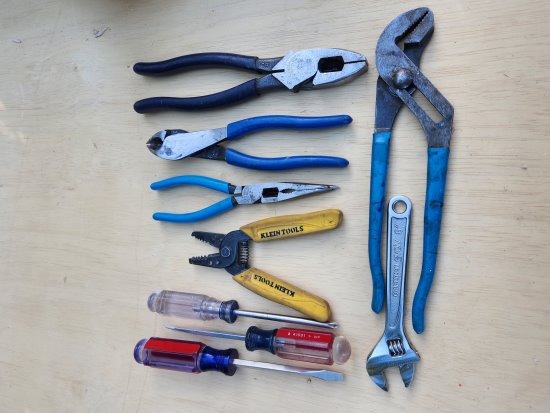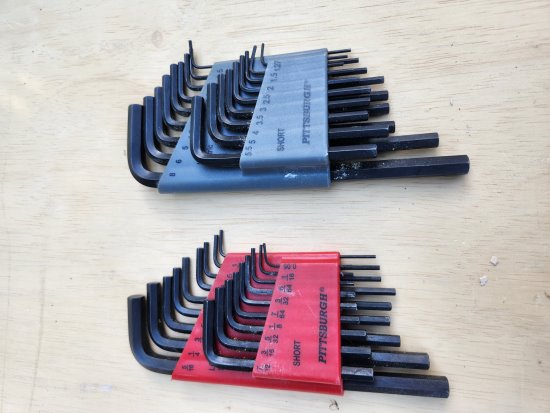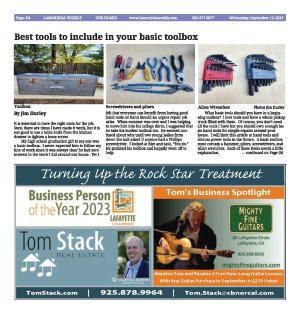| | Published September 13th, 2023
| Best tools to include in your basic toolbox
| | | By Jim Hurley |  | | Toolbox Photo Jim Hurley |
It is essential to have the right tools for the job. Sure, there are times I have made it work, but it is not good to use a table knife from the kitchen drawer to tighten a loose screw.
 My high school graduation gift to my son was a basic toolbox. I never expected him to follow my line of work since it was always clear he had zero interest in the work I did around our house. Yet I felt that everyone can benefit from having good basic tools on hand should an urgent repair job arise. When summer was over and I was helping to move him into his college dorm, I suggested that he take his modest toolbox too. He seemed confused about why until two young ladies from down the hall asked if anyone had a Phillips screwdriver. I looked at him and said, "You do." He grabbed his toolbox and happily went off to help.
My high school graduation gift to my son was a basic toolbox. I never expected him to follow my line of work since it was always clear he had zero interest in the work I did around our house. Yet I felt that everyone can benefit from having good basic tools on hand should an urgent repair job arise. When summer was over and I was helping to move him into his college dorm, I suggested that he take his modest toolbox too. He seemed confused about why until two young ladies from down the hall asked if anyone had a Phillips screwdriver. I looked at him and said, "You do." He grabbed his toolbox and happily went off to help.
 What basic tools should you have in a beginning toolbox? I love tools and have a whole pickup truck filled with them. Of course, you don't need all the tools I have but you should own enough basic hand tools for simple repairs around your house. I will limit this article to hand tools and discuss power tools in the future. A basic toolbox must contain a hammer, pliers, screwdrivers, and Allen wrenches. Each of these items needs a little explanation.
What basic tools should you have in a beginning toolbox? I love tools and have a whole pickup truck filled with them. Of course, you don't need all the tools I have but you should own enough basic hand tools for simple repairs around your house. I will limit this article to hand tools and discuss power tools in the future. A basic toolbox must contain a hammer, pliers, screwdrivers, and Allen wrenches. Each of these items needs a little explanation.
 Hammers. Choosing a hammer is not as simple as you might think. On your visit to the hardware store, you will find more than a dozen different hammers on display. Little tack hammers, finish hammers, framing hammers, roofing hammers, ballpeen hammers, and sledgehammers. But what do you really need? Your first hammer should be a 16-ounce finish hammer with a straight claw (not curved). It will handle most common tasks. Start with a wooden handle hammer. Don't waste your money on any hammer with a tubular metal handle because these inevitably end up with a nasty bend in the shaft.
Hammers. Choosing a hammer is not as simple as you might think. On your visit to the hardware store, you will find more than a dozen different hammers on display. Little tack hammers, finish hammers, framing hammers, roofing hammers, ballpeen hammers, and sledgehammers. But what do you really need? Your first hammer should be a 16-ounce finish hammer with a straight claw (not curved). It will handle most common tasks. Start with a wooden handle hammer. Don't waste your money on any hammer with a tubular metal handle because these inevitably end up with a nasty bend in the shaft.
 Pliers. There are a huge variety of pliers. To start, definitely get a pair of needle nose pliers, get an adjustable wrench, and a pair of lineman pliers. If you want to be better prepared, add a pair of diagonal pliers for cutting wire. The adjustable wrenches (formerly known as Water Pump Pliers), come in different lengths; get a 12-inch pair, and if you sense bigger trouble ahead, get a bigger size for backup. Most needle nose pliers come with a wire cutter built-in, but that is not always convenient for nipping wires. It's useful to have wire cutters and you may also want a pair of wire strippers as well. These, combined with a good set of screwdrivers, will get you through most household issues.
Pliers. There are a huge variety of pliers. To start, definitely get a pair of needle nose pliers, get an adjustable wrench, and a pair of lineman pliers. If you want to be better prepared, add a pair of diagonal pliers for cutting wire. The adjustable wrenches (formerly known as Water Pump Pliers), come in different lengths; get a 12-inch pair, and if you sense bigger trouble ahead, get a bigger size for backup. Most needle nose pliers come with a wire cutter built-in, but that is not always convenient for nipping wires. It's useful to have wire cutters and you may also want a pair of wire strippers as well. These, combined with a good set of screwdrivers, will get you through most household issues.
 Screwdrivers. Screwdrivers come in multiple sizes and tips. You will save money buying a set with a selection of types. Flathead and Phillips screws are most common, but now many screws require Torx bits (different size star-shaped slots). You may want a Torx set (one driver handle with multiple, interchangeable tips). Be sure to buy quality screwdrivers, as cheap ones tend to bend or break on screws that are unwilling to come out. I don't usually recommend a brand name, but I will say that Sears Craftsman is the only screwdriver that I have in my tool bag. Sears usually has packaged sets for Christmas sales (which somehow start in October now). Once you have your quality screwdrivers, never use them as a chisel unless you want to buy new ones.
Screwdrivers. Screwdrivers come in multiple sizes and tips. You will save money buying a set with a selection of types. Flathead and Phillips screws are most common, but now many screws require Torx bits (different size star-shaped slots). You may want a Torx set (one driver handle with multiple, interchangeable tips). Be sure to buy quality screwdrivers, as cheap ones tend to bend or break on screws that are unwilling to come out. I don't usually recommend a brand name, but I will say that Sears Craftsman is the only screwdriver that I have in my tool bag. Sears usually has packaged sets for Christmas sales (which somehow start in October now). Once you have your quality screwdrivers, never use them as a chisel unless you want to buy new ones.
 Allen Wrenches. Allen Wrenches (or Alvin Wrenches for those of you who saw "A Man Called Otto") have hexagonal tips of various sizes which are typically required for set screws. They come in Metric and American Standard sizes. You should buy a set of each to avoid being frustrated when the wrench you have almost-but-doesn't-quite fit the slot and slips instead of loosening the screw.
Allen Wrenches. Allen Wrenches (or Alvin Wrenches for those of you who saw "A Man Called Otto") have hexagonal tips of various sizes which are typically required for set screws. They come in Metric and American Standard sizes. You should buy a set of each to avoid being frustrated when the wrench you have almost-but-doesn't-quite fit the slot and slips instead of loosening the screw.
 There you have your starter set. As you progress in your DIY adventures, I hope you won't hesitate to buy the additional tools you may need for a specific job. A pipe wrench for plumbing, a crescent wrench for nuts, a level for hanging art, a good 25-foot tape measure, and a pry-bar or nail puller may be handy. As I mentioned earlier, buying quality is important if you plan to reuse your tools frequently.
There you have your starter set. As you progress in your DIY adventures, I hope you won't hesitate to buy the additional tools you may need for a specific job. A pipe wrench for plumbing, a crescent wrench for nuts, a level for hanging art, a good 25-foot tape measure, and a pry-bar or nail puller may be handy. As I mentioned earlier, buying quality is important if you plan to reuse your tools frequently.
 Most important be sure to get a toolbox to keep them all in one place. This way you can leave the table knives in the kitchen drawer until mealtime.
Most important be sure to get a toolbox to keep them all in one place. This way you can leave the table knives in the kitchen drawer until mealtime. |
 | | Screwdrivers and pliers Photo Jim Hurley |  | | Allen Wrenche Photo Jim Hurley |  | | Jim Hurley is an independent handyman with over 25 years of experience in residential repairs. Hopefully this free advice is helpful to someone attempting Do-It-Yourself home repairs. The information presented is intended for informational purposes and for use by persons having appropriate technical skill, at their own discretion and risk. | | | | | | | |







